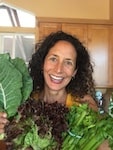
Organic vs GMO’s
By Kris Holden
Summer is in full gear, kids are out of school and the pantry and refrigerator are expected to be stocked with plenty of snacks for hungry active kids. Thankfully, the summer season brings a variety of

delicious fruit that kids enjoy snacking on as well as sweet cherry tomatoes and corn. But how does one navigate buying produce if organic is too expensive or not available? What about GMO’s?
The Environmental Working Group puts out a Dirty Dozen list. The Dirty Dozen is a list of the 12 fruits and vegetables that contain the highest concentrations of pesticides AFTER washing and peeling. The Clean Fifteen, is a list, also put out by the EWG, consisting of 15 fruits and vegetables containing the fewest concentrations of pesticides, which they believe are the safest foods to buy conventionally. The Dirty Dozen and the Clean Fifteen lists are updated annually, as the lists do fluctuate. For instance, kale is now on this years Dirty Dozen list, ranked at number 3. Strawberries have maintained their number 1 spot, for the past 4 years, as being the most contaminated with pesticides. I like to keep a copy of the Dirty Dozen and Clean Fifteen list on my phone for quick reference while shopping.
Genetically Modified Organisms or GMO’s are another thing that I pay attention to while grocery shopping. These are prevalent in many of the foods we all eat, including produce, meat, eggs, dairy and up to 75% of all processed foods. GMO, refers to plants and animals whose genetic material has been changed in ways that

do not occur naturally. When you see the “non-GMO” seal it means that the food is made without ingredients that were derived from genetically engineered organisms. The USDA requires manufacturers to disclose if their products are “bioengineered” or contain genetically modified ingredients. The issue is that there are many ways for the manufacturers to get around having to disclose this.
For meat, poultry, dairy and eggs the “non-GMO” seal claims that animals were not fed a diet containing GM crops, but the USDA does not require on-farm inspection or yearly paperwork audits. For processed foods, plant-based foods, eggs and dairy products, there is no common standard that companies have to meet for labeling if it’s made with GM ingredients. The Food and Drug Administration or FDA, does not require safety testing or safety assessments of genetically modified crops before they are sold.
The 10 most genetically modified crops in the US are: soybean, corn, sugar beets, canola (rapeseed), cotton, Hawaiian papaya, alfalfa, apples, potatoes, and summer squash. Much of the corn and soybeans, as well as alfalfa, are used as animal feed for beef, pigs, poultry and dairy cows. Most produce, grown in the US, is GMO-free with the exception of those listed above. With all this being said about pesticides and GMO’s it’s far more important to continue to eat mostly fruit and vegetables, regardless of it being organic or not, as the health benefits outweigh the risks.
There are a few ways you can choose to avoid GMO foods. When looking at labels on packages there are some verified seals that will assure you the food does not contain GMO ingredients or pesticides. Look for: Non-GMO Project Verified, GMO Guard, USDA Organic Seal, Certified Organic or 100% Organic. Additionally, Aptos Natural Foods store has committed to being GMO-free as well as 100% of their produce organic. Lastly, preparing your own food at home, with the ingredients of your choosing, is always the healthiest way for you and your family.
The following is a treat that our whole family enjoys.
Kris Holden is a mother of three teens. She’s always been passionate about health and nutrition and eager to share with others what’s worked for her and her family. She’s a Feel Good Coach with focus on healing and energizing through a plant based whole foods lifestyle. You can view other recipes and healthy food selections on Instagram @feelgoodpicks. Email: [email protected]
Recipe: Banana Ice Cream
Ingredients:
- 2-3 overripe, frozen bananas*
- optional milk of choice, if needed. (oat milk, coconut milk, nut milk)
- pinch of salt
Instructions:
1) Start with bananas that are turning brown, they’re sweeter. Peel and cut into several pieces, then freeze in an airtight bag or container. (You can freeze a whole bunch at once so they’re ready whenever you want to make banana ice cream or a smoothie.)
2) To make the ice cream, put around, the equivalent, of 2-3 frozen bananas into a high speed blender or food processor.
3) Add a pinch of salt and 2-4 tbsp of milk for a smoother blending, if desired.
4) Blend until you achieve a soft-serve consistency.
5) You can serve immediately, or transfer to a container and freeze an additional 30 minutes, then scoop out with an ice cream scoop.
There are a variety of flavors that you can add with this base.
Our favorite is adding 2-3 tbsp of peanut butter and 3 tbsp of cocoa powder.
You can also add your favorite berries or fresh mint.
For a pina colada flavor use 1/4 cup canned coconut milk and 1/2 cup frozen pineapple.
Recipe by chocolatecoveredkatie.com
*Bananas provide 3 grams of fiber, 450 mg of potassium, vitamin C and a variety of other vitamins and minerals.
The 2019 Dirty Dozen List:
- Strawberries
- Spinach
- Kale
- Nectarines
- Apples
- Grapes
- Peaches
- Cherries
- Pears
- Tomatoes
- Celery
- Potatoes
The 2019 Clean Fifteen List:
- Avocados
- Sweet Corn
- Pineapples
- Frozen Sweet Peas
- Onions
- Papayas
- Eggplants
- Asparagus
- Kiwis
- Cabbages
- Cauliflower
- Cantaloupes
- Broccoli
- Mushrooms
- Honeydew Melons


You May Also Like

Cabrillo College Wins NASA Swarmathon: Around Town August 2019
August 1, 2019
Happy and Successful Kids Lifeskill 4: Making Connections
August 1, 2019

